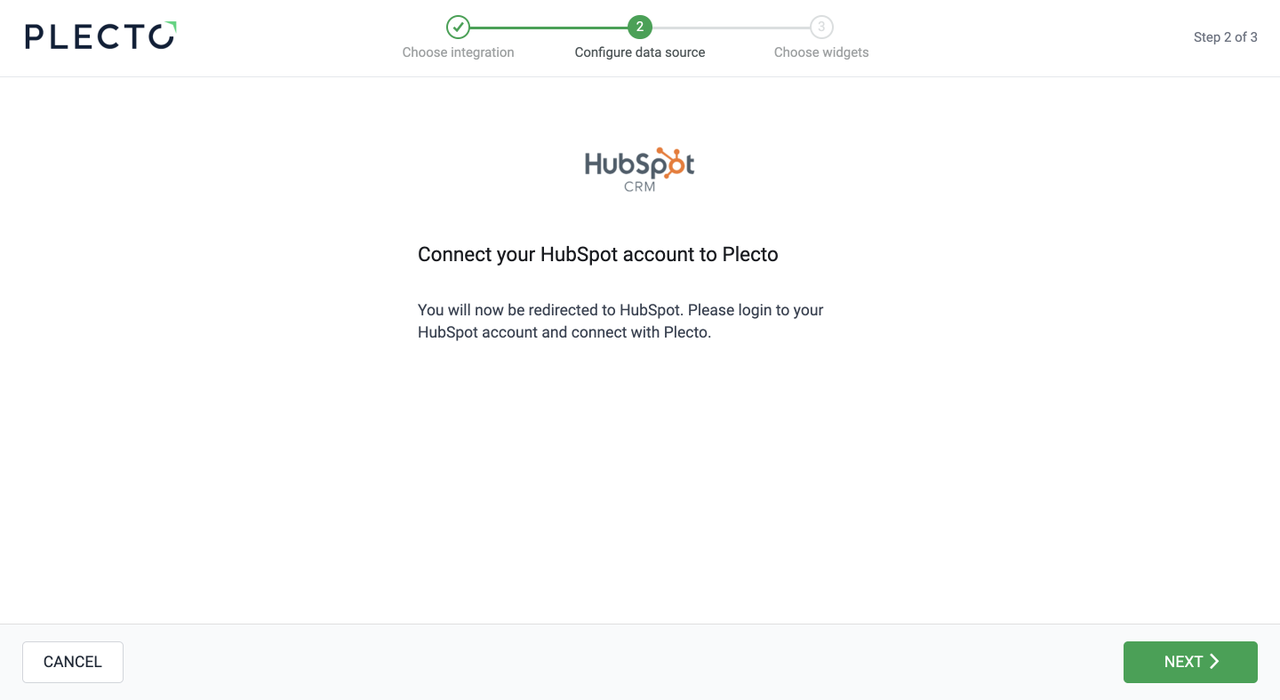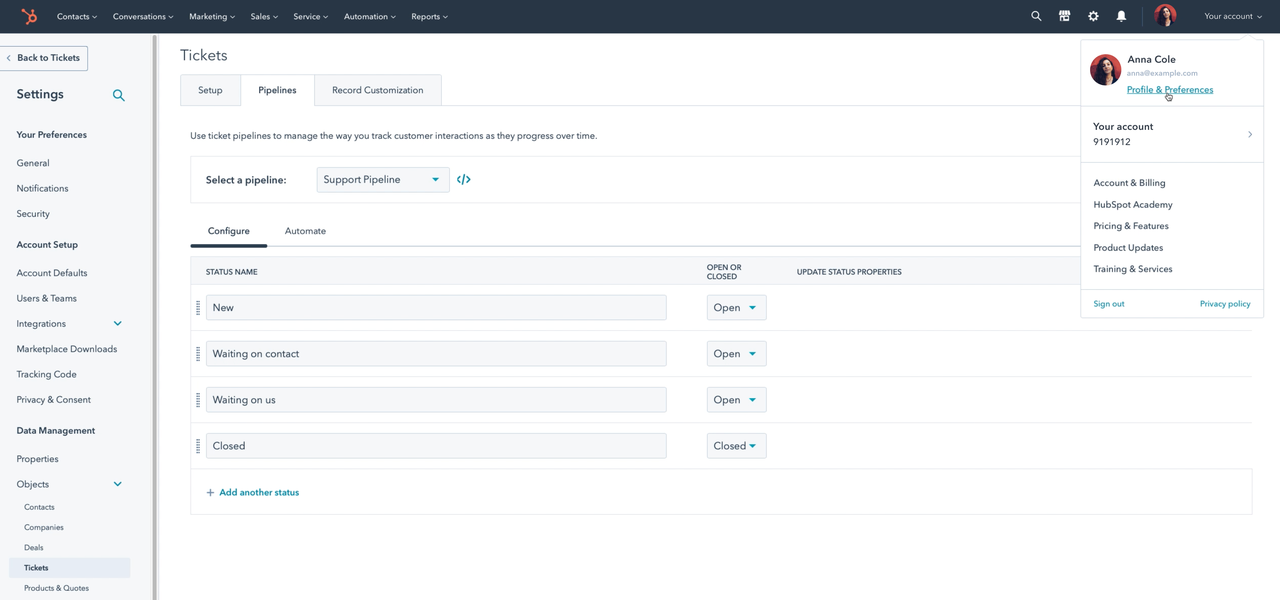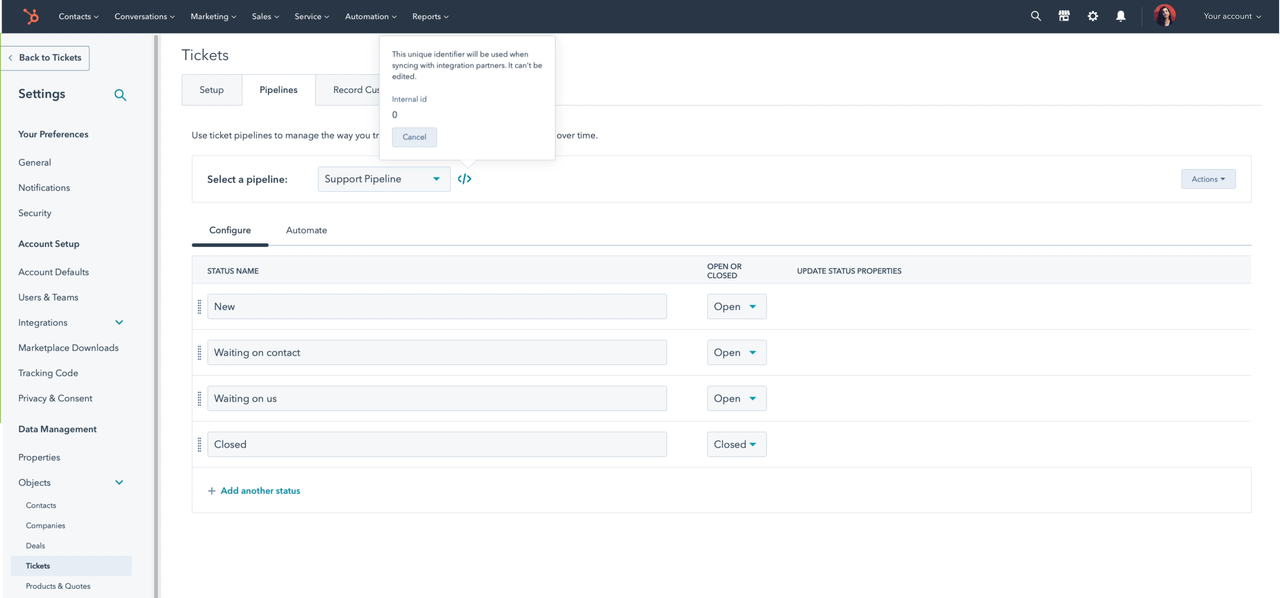
How to integrate HubSpot with Plecto
Go to Data sources > New data source > HubSpot.
Click Next and log in to your HubSpot account.
Click Grant access to give Plecto permission to access your HubSpot data.
Select the data you want to import.
Configure your data source settings. Here, you can change the title, choose the default date, select which fields to import, and more.
Click Next to choose how much data to import and how long you want to keep it in the data source.
Click Import to finish.
Available data
Import data directly from HubSpot and create real-time dashboards and reports for your CRM KPIs. Currently, you can import the following data from HubSpot:
Calls
Update frequency: 2m
Default member field: ownerId
Default date field: createdAt
Supports custom fields? No
Supports webhooks? No
Supports automatic registration deletion? No
Supports relations? Yes
Campaigns
Update frequency: 2m
Supports custom fields? No
Supports webhooks? No
Supports automatic registration deletion? No
Supports relations? No
Contacts
Update frequency: 2m
Default member field: hubspot_owner_id
Default date field: addedAt
Supports custom fields? Yes
Supports webhooks? Yes
Supports automatic registration deletion? Yes
Supports relations? Yes
Companies
Update frequency: 15m
Default member field: hubspot_owner_id
Default date field: createdate
Supports custom fields? Yes
Supports webhooks? Yes
Supports automatic registration deletion? Yes
Supports relations? Yes
Custom Data Types
Update frequency: 2m
Supports custom fields? Yes
Supports webhooks? No
Supports automatic registration deletion? No
Supports relations? Yes
Deals
Update frequency: 2m
Default member field: hubspot_owner_id
Default date field: createdate
Supports custom fields? Yes
Supports webhooks? Yes
Supports automatic registration deletion? Yes
Supports relations? Yes
Emails
Update frequency: 2m
Default member field: ownerId
Default date field: createdAt
Supports custom fields? No
Supports webhooks? No
Supports automatic registration deletion? No
Supports relations? Yes
Feedback Submissions
Update frequency: 2m
Supports custom fields? No
Supports webhooks? No
Supports automatic registration deletion? No
Supports relations? Yes
Forms
Update frequency: 2m
Supports custom fields? Yes
Supports webhooks? No
Supports automatic registration deletion? No
Supports relations? Yes
Notes
Update frequency: 2m
Default member field: ownerId
Default date field: createdAt
Supports custom fields? No
Supports webhooks? No
Supports automatic registration deletion? No
Supports relations? Yes
Line Items
Update frequency: 2m
Supports custom fields? No
Supports webhooks? No
Supports automatic registration deletion? No
Supports relations? Yes
Lists
Update frequency: 15m
Supports custom fields? No
Supports webhooks? No
Supports automatic registration deletion? No
Supports relations? No
Marketing Emails
Update frequency: 2m
Supports custom fields? No
Supports webhooks? No
Supports automatic registration deletion? No
Supports relations? Yes
Meetings
Update frequency: 2m
Default member field: ownerId
Default date field: createdAt
Supports custom fields? Yes
Supports webhooks? No
Supports automatic registration deletion? No
Supports relations? Yes
Tasks
Update frequency: 2m
Default member field: ownerId
Default date field: createdAt
Supports custom fields? No
Supports webhooks? No
Supports automatic registration deletion? No
Supports relations? Yes
Tickets
Update frequency: 2m
Default member field: hubspot_owner_id
Default date field: createdate
Supports custom fields? Yes
Supports webhooks? No
Supports automatic registration deletion? No
Supports relations? Yes
Quotes
Update frequency: 2m
Supports custom fields? No
Supports webhooks? No
Supports automatic registration deletion? No
Supports relations? Yes

How to find Pipeline ID in Tickets
When we import Tickets, we import a field called Pipeline. This field only shows the ID of the pipeline, and if you want to know which pipeline it represents, you have to look in HubSpot.
Knowing the name of the pipeline can help you filter your data by the correct ID in Plecto (for example, when building formulas or creating KPIs on dashboards).
Here's how to find the Pipeline ID in HubSpot
Open HubSpot, click on your account in the top-right and open Profile & Preferences.
Navigate to Data Management > Objects > Tickets and open the Pipelines tab.
Select the pipeline of which you'd like to see the ID.
Click on the </> icon next to the pipeline name to see the ID.
Registration deletion and updating
Plecto uses webhooks to delete registrations in Contacts, Companies, Deals and to update registrations in Contacts, Companies.
We also support deleting registrations in Tickets, but this action happens with each automatic import and is not related to webhooks.


